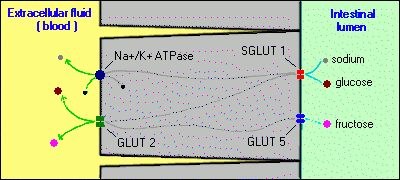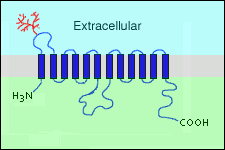VIVO Pathophysiology
Other Topics
Hexose Transporters
The hexoses glucose, galactose and fructose serve as important dietary energy sources in animals and glucose plays a central role in energy homeostasis within eucaryotic cells. These molecules are unable to diffuse passively across cellular membranes, and require transporter proteins for entry into and exit from cells. Two distinct groups of hexose transporters have been identified and classified based on their dependence on cellular energy:
- Transport hexoses down a concentration gradient: GLUT1, GLUT2, GLUT3, GLUT4 and GLUT5.
- Tranport hexoses against a concentration gradient using energy provided by an electrochemical gradient of sodium, which is cotransported with the hexose: SGLUT1, SGLUT2.
Each of the transporters has different affinities for glucose and the other hexoses, which largely dictates their function. GLUT1, 3 and 4 have a high affinity for glucose (Km = 2-5 mM), which indicates that they are functioning at maximal rate under physiologic concentrations of glucose (~5 mM). In contrast, GLUT2 has a low affinity for glucose (Km ~15 mM), which allows it to change transport rate in proportion to the increasing glucose concentrations that occur after ingestion of a carbohydrate-rich meal.
Hexose transporters also have fairly distinctive patterns of expression among tissues. Many cells express more than one hexose transporter.
Consider for example, small intestinal epithelial cells, which must absorb glucose, galactose and fructose from the intestinal lumen, then export those sugars into blood. This cell has at least three hexose transporters. The apical membrane contains the sodium-glucose cotransporter SGLUT1, which allows the cell to take up glucose and galactose by cotransport with sodium, and GLUT5, which mediates absorption of fructose. On the basolateral plasma membranes is GLUT2 (and perhaps others), which allows diffusion of all three of these monosaccharides out of the cell into extracellular fluid and ultimately, into blood.

The hexose transporters are large integral membrane proteins. Based on the deduced amino acid sequences of their cloned cDNAs, they have similar structures, consisting of 12 membrane-spanning regions with cytoplasmic C-terminal and N-terminal tails. Also, they all appear to be glycosylated on one of the extracellular loops.

Transport of sugars across membranes appears to result from a series of confirmational changes which "flips" the transporter between alternate states with the substrate binding site either facing the extracellular or cytoplasmic side of the membrane. Transport in either direction is thus possible, depending on relative substrate concentrations on either side of the membrane.
Salient characteristics of the well characterized hexose transporters are summarized in the table below. A total of 5 SGLUT proteins and 14 GLUT proteins have been identified to date. It should also be recognized that at least small amounts of these transporters are expressed in a wide variety of cell types other than those major sites listed.
| Transporter | Major Sites of Expression | Characteristics |
|---|---|---|
| SGLUT1 | Intestinal mucosa, kidney tubules | Cotransports one molecule of glucose or galactose along with two sodium ions. Does not transport fructose. |
| SGLUT2 | Kidney tubules | Cotransports glucose and sodium ion. Does not transport galactose or fructose. |
| GLUT1 | Brain, erythrocyte, endothelial cells, fetal tissues | Transports glucose (high affinity) and galactose, not fructose. Expressed in many cells. |
| GLUT2 | Liver, pancreatic beta cell, small intestine, kidney. | Tranports glucose, galactose and fructose. A low affinity, high capacity glucose transporter; serves as a "glucose sensor" in pancreatic beta cells. |
| GLUT3 | Brain, placenta and testes | Transports glucose (high affinity) and galactose, not fructose. The primary glucose transporter for neurons. |
| GLUT4 | Skeletal and cardiac muscle, adipocytes | The insulin-responsive glucose transporter. High affinity for glucose. |
| GLUT5 | Small intestine, sperm | Transports fructose, but not glucose or galactose. Present also in brain, kidney, adipocytes and muscle. |
References and Reviews
- Shepherd PR, Kahn BB: Glucose transporters and insulin action. New Eng J Med 341:248-257, 1999.
- Thorens B, Mueckler M: Glucose transporters in the 21st Century. Am J Physiol Endocrinol Metab 298: E141–E145, 2010.
- Wright EM, Loo DDF, Hirayama BA: Biology of Human Sodium Glucose Transporters. Physiol Rev 91:733–794, 2011,
Send comments to Richard.Bowen@colostate.edu